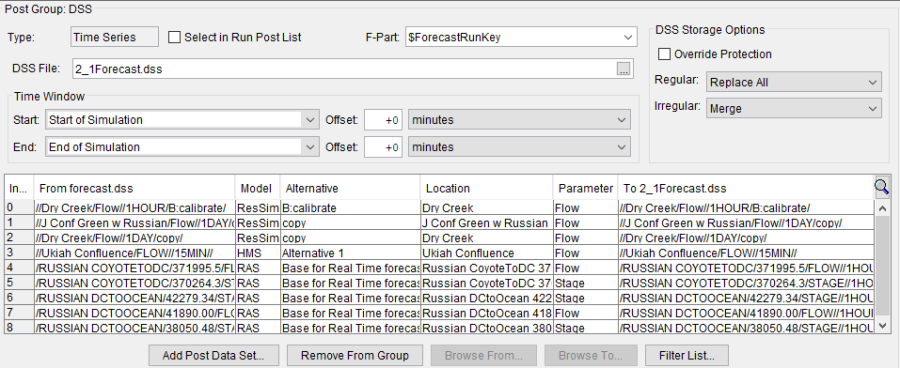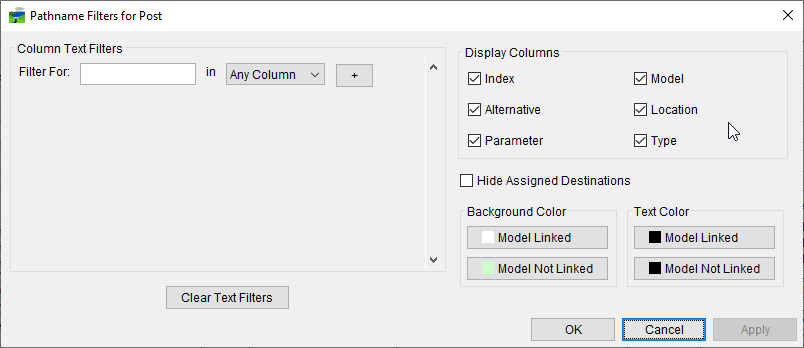Post Editor
Now that you have successfully computed a forecast and reviewed results, you might want to save data from the forecast.dss file to other DSS files. A post is created and defined from the Post Editor. From the Setup module, from the Models menu, click Edit Post, the Post Editor will open.
The Post Editor is comprised of two sections: Available Output and Post Linking. The Available Output section contains a table that lists the output records from each model alternative. The Post Linking section contains information on the defined post groups, and contains a table, which lists the output records and sources records assigned to a post group.
Available Output Section
The Available Output section (Figure 1) provides a list of the model alternative output time series records that can be mapped to the CWMS database or other DSS files.

The Available Output Table provides the following information:
Model this column lists which software application created the output record.
Alternative this column lists the model alternative name that created the output record.
Location this column displays the name of the model object that is associated with the output record.
Parameter this column displays the parameter associated with the output record.
Type this column specifies if the record is times series data or gridded data. Types include GRID or TIME_SERIES. GRID represents DSS gridded data. TIME_SERIES represents time series data.
Model Output this column displays the actual output record pathname that a model alternative creates. This is the pathname that will be written to the forecast.dss file during the compute.
Index Each time series pathname is assigned an Index number when it is loaded into the Post Editor. This number has no real usage except keeping the initial filtered list set. There can be multiple indices for a single DSS pathname.
This information does not display by default in the Available Output table, you will need to set up the table view.
Post Linking Section
The Post Linking section (Figure 2) displays information on the post groups. Post groups link similar time series output data to a single data destination. The destination can be a DSS file or a WISKI database (WISKI Extract and Post). The destination records will be mapped to the required output records in a post group. During a forecast compute, the destination records will be copied into the required output pathnames when are created in the forecast.dss file.

The Post Linking section provides information on the following:
From forecast.dss this column lists the selected model alternative's output records for a post group. This data will fill the DSS record displayed in the To <data_source> column.
Model this column lists which software application generates the output data.
Alternative this column lists the model alternative that is created the output record.
Location this column displays the name of the model location object that is associated with the output record.
Parameter this column displays the parameter associated with the output record's data.
To <data_source> this column displays the output record pathname that will be written to the To <data_source> during the post process.
Index Each required destination pathname is assigned an Index number when it is loaded into the Post Editor. This number has no real usage except keeping the initial filtered list set. There can be multiple indices for a single DSS pathname.
This information does not display by default in the Post Linking table, you will need to set up the table view.
Table View Options
You can change the amount of information displayed in the tables in both the Available Output and the Post Linking sections. Clicking on the magnifying glass icon (![]() ) at the top right-hand corner of the tables in each section displays the Pathname Filters for Post dialog (Figure 3).
) at the top right-hand corner of the tables in each section displays the Pathname Filters for Post dialog (Figure 3).

From the Column Text Filters box (Figure 3) you can filter the records to display only records that contain a certain phrase or string of text. Filtering can be done by Column, Index, Model, Alternative, Location, Parameter, Type, or Model Output. You can filter for multiple requirements by clicking +. Below are examples of several different ways that you can filter:
- Filters can be used to retrieve only records that are an exact match. You can do this by typing a string of text in the Filter For: box.
- Filters can be used to retrieve records that start, end, or contain a specific string. To do this, use an asterisk (*) after, before, or inserted into the string of text you want to filter for.
From the Display Columns box (Figure 3) you can select which columns in the table to view. For the examples in this chapter, Index, Model, Alternative, Location, Parameters, and Type have been selected for the tables in each section of the Post Editor.
You can remove a record from a table that has already been assigned to an extract group, select Hide Assigned Destinations (Figure 3). The Hide Assigned Destinations option is not available for the Post Linking section. For the examples in this chapter, Hide Assigned Destinations has not been selected.
You can also color code the output records listed in the Available Output section (Figure 3) depending on if the output record is linked to a destination record. You can color code by background or text. For example, to add a background color to a record that is not linked, from the Background Color box (Figure 3), click Model Not Linked, a Color Chooser dialog will open (Using the Color Chooser). Select a color, click OK, the Color Chooser will close, and from the Model Output column of the Available Output table, any record that has not been linked will be highlighted in the selected color (Figure 3).
You can also color code the records listed in the Post Linking section (Figure 4) when an output record is not used by a model. You can color code by background or text. For example, in Figure 4, to add a background color to a record that is not used by a model, from the Background Color box (Figure 4), click Not Used by Model, a Color Chooser dialog will open (Using the Color Chooser). Select a color, click OK, the Color Chooser will close, and from the Post Linking table, any record that has not been used by a model will be highlighted in the selected color.
